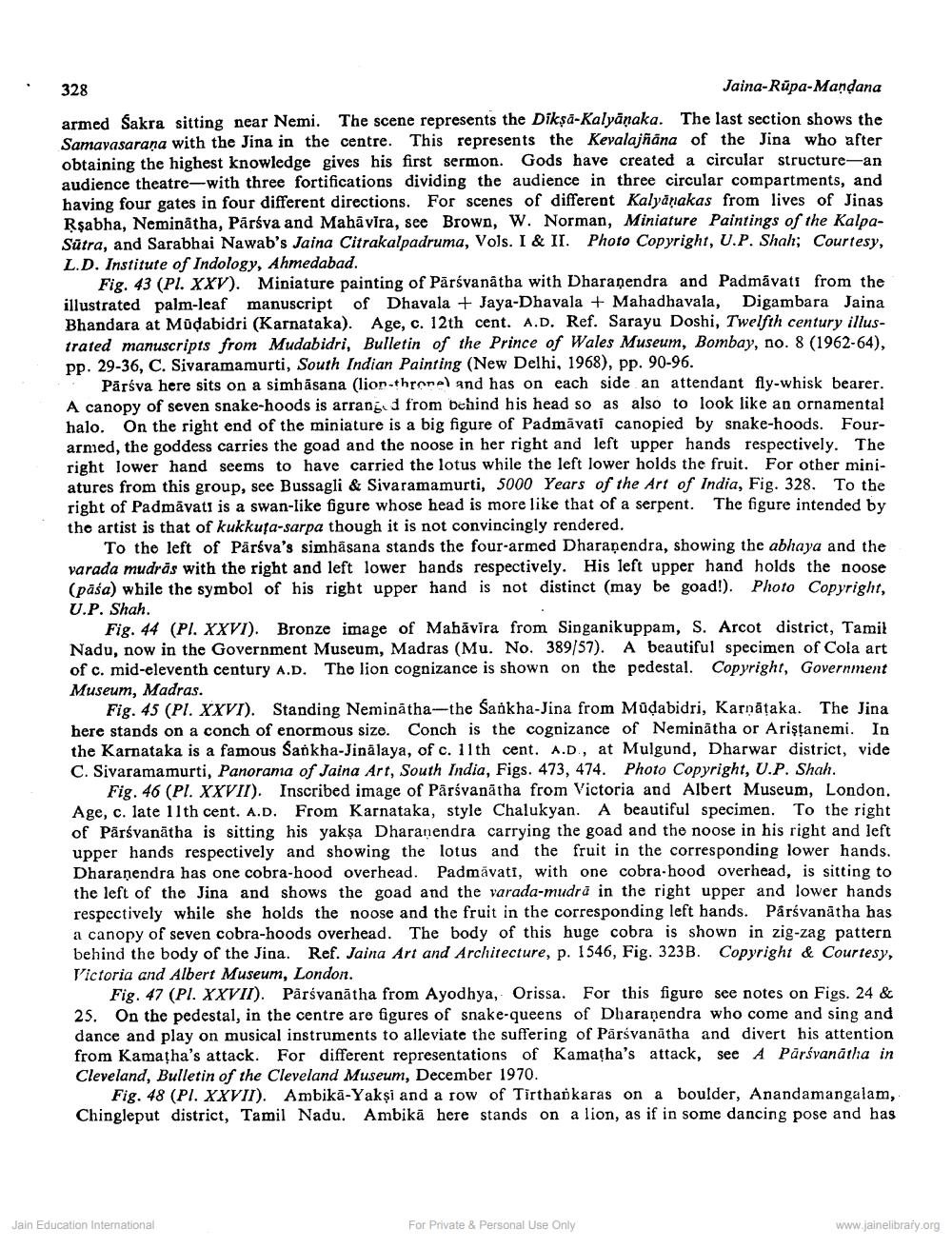________________
328
Jaina-Rupa-Mandana armed Sakra sitting near Nemi. The scene represents the Dikșa-Kalyāṇaka. The last section shows the Samavasarana with the Jina in the centre. This represents the Kevalajñana of the Jina who after obtaining the highest knowledge gives his first sermon. Gods have created a circular structure-an audience theatre-with three fortifications dividing the audience in three circular compartments, and having four gates in four different directions. For scenes of different Kalyanakas from lives of Jinas Rsabha, Neminátha, Pārsva and Mahavira, sce Brown, W. Norman, Miniature Paintings of the KalpaSūtra, and Sarabhai Nawab's Jaina Citrakalpadruma, Vols. I & II. Photo Copyright, U.P. Shah; Courtesy, L.D. Institute of Indology, Ahmedabad.
Fig. 43 (Pl. XXV). Miniature painting of Pārsvanatha with Dharanendra and Padmavati from the illustrated palm-leaf manuscript of Dhavala + Jaya-Dhavala + Mahadhavala, Digambara Jaina Bhandara at Mudabidri (Karnataka). Age, c. 12th cent. A.D. Ref. Sarayu Doshi, Twelfth century illustrated manuscripts from Mudabidri, Bulletin of the Prince of Wales Museum, Bombay, no. 8 (1962-64), pp. 29-36, C. Sivaramamurti, South Indian Painting (New Delhi, 1968), pp. 90-96.
Pārsva here sits on a simhasana (lion-thronel and has on each side an attendant fly-whisk bearer. A canopy of seven snake-hoods is arrangi from behind his head so as also to look like an ornamental halo. On the right end of the miniature is a big figure of Padmăvati canopied by snake-hoods. Fourarmed, the goddess carries the goad and the noose in her right and left upper hands respectively. The right lower hand seems to have carried the lotus while the left lower holds the fruit. For other miniatures from this group, see Bussagli & Sivaramamurti, 5000 Years of the Art of India, Fig. 328. To the right of Padmavati is a swan-like figure whose head is more like that of a serpent. The figure intended by the artist is that of kukkufa-sarpa though it is not convincingly rendered.
To the left of Pärśva's simhasana stands the four-armed Dharanendra, showing the abhaya and the varada mudrās with the right and left lower bands respectively. His left upper hand holds the noose (pāśa) while the symbol of his right upper hand is not distinct (may be goad!). Photo Copyright, U.P. Shah.
Fig. 44 (Pl. XXVI). Bronze image of Mahāvira from Singanikuppam, S. Arcot district, Tamil Nadu, now in the Government Museum, Madras (Mu. No. 389/57). A beautiful specimen of Cola art of c. mid-eleventh century A.D. The lion cognizance is shown on the pedestal. Copyright, Government Museum, Madras.
Fig. 45 (Pl. XXVI). Standing Neminātha--the Sankha-Jina from Müdabidri, Karnataka. The Jina here stands on a conch of enormous size. Conch is the cognizance of Neminātha or Arişğanemi. In the Karnataka is a famous Sankha-Jinālaya, of c. 11th cent. A.D., at Mulgund, Dharwar district, vide C. Sivaramamurti, Panorama of Jaina Art, South India, Figs. 473, 474. Photo Copyright, U.P. Shah.
Fig. 46 (Pl. XXVII). Inscribed image of Pārsvanātha from Victoria and Albert Museum, London. Age, c. late 11th cent. A.D. From Karnataka, style Chalukyan. A beautiful specimen. To the right of Pārsvanātha is sitting his yaksa Dharanendra carrying the goad and the noose in his right and left upper hands respectively and showing the lotus and the fruit in the corresponding lower hands. Dharanendra has one cobra-hood overhead. Padmavati, with one cobra-hood overhead, is sitting to the left of the Jina and shows the goad and the varada-mudrà in the right upper and lower hands respectively while she holds the noose and the fruit in the corresponding left hands. Parsvanatha has a canopy of seven cobra-hoods overhead. The body of this huge cobra is shown in zig-zag pattern behind the body of the Jina. Ref. Jaina Art and Architecture, p. 1546, Fig. 323B. Copyright & Courtesy, Victoria and Albert Museum, London.
Fig. 47 (Pl. XXVII). Pårsvanatha from Ayodhya, Orissa. For this figuro see notes on Figs. 24 & 25. On the pedestal, in the centre aro figures of snake-queens of Dharanendra who come and sing and dance and play on musical instruments to alleviate the suffering of Pārsvanatha and divert his attention from Kamatha's attack. For different representations of Kamatha's attack, see A Parsvanátha in Cleveland, Bulletin of the Cleveland Museum, December 1970.
Fig. 48 (Pl. XXVII). Ambika-Yakşi and a row of Tirthankaras on a boulder, Anandamangalam, Chingleput district, Tamil Nadu. Ambikā here stands on a lion, as if in some dancing pose and has
Jain Education International
For Private & Personal Use Only
www.jainelibrary.org




